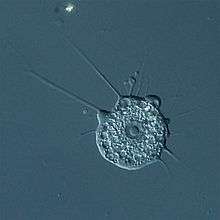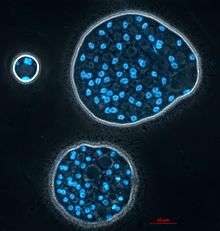Apoikozoa
| Apoikozoa Temporal range: Neoproterozoic–Recent Molecular clock evidence for origin between 1050 and 800Ma[1] | |
|---|---|
| Scientific classification | |
| (unranked): | Unikonta |
| (unranked): | Obazoa |
| (unranked): | Opisthokonta |
| (unranked): | Holozoa |
| (unranked): | Filozoa |
| (unranked): | Apoikozoa Budd & Jensen, 2015 |
| Subdivisions | |
| Synonyms | |
|
Choanimal Fairclough et al., 2013 | |
The Apoikozoa is a clade of opisthokont eukaryotes consisting of the Animalia and Choanoflagellatea. The sister-group relationship between the choanoflagellates and animals has important implications for the origin of the animals.[2] It was identified in 2015 by Graham Budd and Sören Jensen.[3]
Introduction
A close relationship between choanoflagellates and animals has long been recognised, dating back at least to the 1840s. A particularly striking and famous similarity between the single-celled choanoflagellates and multicellular animals is provided by the collar cells of sponges and the overall morphology of the choanoflagellate cell, and this has been confirmed by multiple molecular analyses since. This proposed homology has however been thrown into some doubt recently by the still controversial suggestion that ctenophores and not sponges are the sister group to all other animals.[4][5] More recent genomic work has suggested that choanoflagellates possess some of the important genetic machinery necessary for the multicellularity of animals.
The name "Apoikozoa", derived from the ancient Greek for "colony" and "animal", refers to the ability of both the animals and (some) choanoflagellates to form multicellular units. While animals are permanently multicellular, the colony-building choanoflagellates are only sometimes so, which raises the question of whether or not the colony building ability in both groups was present at the base of the entire clade, or whether it was independently derived within the animals and choanoflagellates. In either case, these two groups are the only heterotrophs known to form colonies.
Evolutionary implications
Although the last common ancestor of the Apoikozoa cannot be reconstructed with certainty, Budd and Jensen suggest that these organisms formed benthic colonies that competed for space amongst other mat-forming organisms known to have existed during the Ediacaran Period some 635–540 million years ago. As such they would form an important link between the unicellular ancestors of the animals and the enigmatic "Ediacaran"' organisms known from this interval, thus allowing some sort of reconstruction of the earliest animals and their ecology. In the following cladogram it is indicated approximately how many million years ago (Mya) the clades diverged into newer clades.[6][7][8] (Note that the later Budd and Jensen paper gives significantly younger dates. See also Kimberella)
| Opisthokonta |
| ||||||||||||||||||||||||||||||||||||||||||||||||||||||
| 1300 mya |
References
- ↑ Wegener-Parfrey, Laura; Lahr DJ; Knoll AH; Katz LA (August 16, 2011). "Estimating the timing of early eukaryotic diversification with multigene molecular clocks". PNAS. 108 (33): 13624–13629. doi:10.1073/pnas.1110633108. PMC 3158185. PMID 21810989.
- ↑ King, N.; Westbrook, M.J.; Young, S.L.; Kuo, A.; Abedin, M.; Chapman, J.; Fairclough, S.; Hellsten, U.; Isogai, Y.; Letunic, I. (February 14, 2008). "The genome of the choanoflagellate Monosiga brevicollis and the origin of metazoans". Nature. 451 (7180): 783–8. doi:10.1038/nature06617. PMC 2562698. PMID 18273011.
- ↑ Budd, G. E. & Jensen, S. (2015). "The origin of the animals and a 'Savannah' hypothesis for early bilaterian evolution". Biological Reviews: n/a. doi:10.1111/brv.12239. PMID 26588818.
- ↑ Ryan JF (December 13, 2013). "The genome of the ctenophore Mnemiopsis leidyi and its implications for cell type evolution". Science. 342 (6164): 1242592. doi:10.1126/science.1242592. PMC 3920664. PMID 24337300.
- ↑ Pisani, D.; Pett, W.; Dohrmann, M.; Feuda, R.; Rota-Stabelli, O.; Philippe, H.; Lartillot, N. & Wörheide, G. (December 15, 2015). "Genomic data do not support comb jellies as the sister group to all other animals". Proceedings of the National Academy of Sciences. 112 (50): 15402. doi:10.1073/pnas.1518127112. PMC 4687580. PMID 26621703.
- ↑ Peterson, Kevin J.; Cotton, James A.; Gehling, James G.; Pisani, Davide (2008-04-27). "The Ediacaran emergence of bilaterians: congruence between the genetic and the geological fossil records". Philosophical Transactions of the Royal Society of London B: Biological Sciences. 363 (1496): 1435–1443. doi:10.1098/rstb.2007.2233. PMC 2614224. PMID 18192191.
- ↑ Parfrey, Laura Wegener; Lahr, Daniel J. G.; Knoll, Andrew H.; Katz, Laura A. (2011-08-16). "Estimating the timing of early eukaryotic diversification with multigene molecular clocks". Proceedings of the National Academy of Sciences. 108 (33): 13624–13629. doi:10.1073/pnas.1110633108. PMC 3158185. PMID 21810989.
- ↑ Hehenberger, Elisabeth; Tikhonenkov, Denis V.; Kolisko, Martin; Campo, Javier del; Esaulov, Anton S.; Mylnikov, Alexander P.; Keeling, Patrick J. (2017). "Novel Predators Reshape Holozoan Phylogeny and Reveal the Presence of a Two-Component Signaling System in the Ancestor of Animals". Current Biology. 27 (13): 2043–2050.e6. doi:10.1016/j.cub.2017.06.006.

